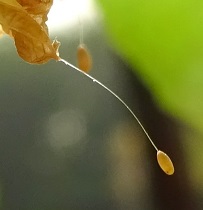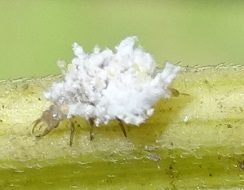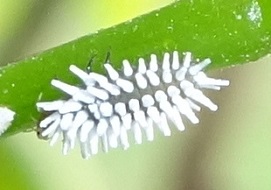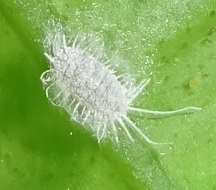| Home | Nature Weekly Index |
15 November 2015 | Lacewing Eggs and Lavae | Udumbara Flowers |

 When I saw the first
Green Lacewing (Chrysoperla rufilabris)
that flew into my home back in June 2014, I briefly
shared the Buddhist legend on the so called mystical flower or Udumbara. Some folks apparently believe that the
eggs from the lacewing are actually bundle of tiny flowers that have significant meaning or pointing to some
divine signs. On Tuesday this week, I found some lacewing eggs, 8 of them in total, hanging from a
Chinese Motherwort (Leonurus japonicus) plant in my pot.
With this sighting, I decided to re-visit this topic and did a more thorough check on the Udumbara story.
When I saw the first
Green Lacewing (Chrysoperla rufilabris)
that flew into my home back in June 2014, I briefly
shared the Buddhist legend on the so called mystical flower or Udumbara. Some folks apparently believe that the
eggs from the lacewing are actually bundle of tiny flowers that have significant meaning or pointing to some
divine signs. On Tuesday this week, I found some lacewing eggs, 8 of them in total, hanging from a
Chinese Motherwort (Leonurus japonicus) plant in my pot.
With this sighting, I decided to re-visit this topic and did a more thorough check on the Udumbara story.
Based on the information from Wikipedia, udumbara refers to the Cluster Fig (Ficus racemosa), a tree that looks very similar to Ficus fistulosa (Common Yellow Stem Fig). According to the legend, the flowers of this tree bloom only once in every 3,000 years. The legend seemed to came about in order to explain the absence of the flower on this tree. Today, most of us will know why there is no flower on a fig tree. Simply, the tiny fig flowers are hidden within the fruit or syconium of the fig. Pollination of the flowers are performed by tiny wasps that squeeze themselves through a small opening at the tip of the fruit.
.jpg) The so called Udumbara blossoms were first reported in 1997 in South Korea. Suddenly, many people all over the world started to see
these "little mysterious flowers" on all kind of surfaces. Since no one had ever seen a Udumbara flower, it was kind of strange that
the first individual could clearly determine that what he/she chanced upon was actually the divine flower. Following on, many people
simply jump on the bandwagon and proclaim the truth in this strange discovery. Such is the power of misbelief.
The so called Udumbara blossoms were first reported in 1997 in South Korea. Suddenly, many people all over the world started to see
these "little mysterious flowers" on all kind of surfaces. Since no one had ever seen a Udumbara flower, it was kind of strange that
the first individual could clearly determine that what he/she chanced upon was actually the divine flower. Following on, many people
simply jump on the bandwagon and proclaim the truth in this strange discovery. Such is the power of misbelief.
The so called prove that the object was indeed flowers came in 2009 from someone in Malacca, a state in Malaysia. A person by the name of Mr Li placed the object collected under a microscope and claim that the petals and stamens were clearly visible. When I looked at the picture posted in the Internet, it did not occur to me that the object looked like a flower. For a more comprehensive assessment of this myth, you can read the article from the In Defense of Plants website.
Coming back to the lacewing eggs on my plant, they actually hatched on the same day that I spotted them. The moment came in the late afternoon. It was reported that lacewing eggs took a few days to hatch. I was not certain when the eggs were laid. The larvae were so tiny that I was not able to capture any clear pictures on them. All I could see was a very tiny hairy creature holding onto the surface of each egg.
Today, while inspecting my pots, I managed to locate 2 larvae. Interestingly, the back of the larvae was covered with whitish materials that made them look like the mealy bugs on some of the plants. If not because of their fast movement, I would have thought that they were just another of the many mealy bugs. In the 4 magnified pictures below, two of them were the lacewing larvae, one was a nymph of the ladybird beetle which I shared a few weeks back and the last one was a real mealy bug. Just by inspecting them on the plant, it was difficult to differentiate them due to their small size.




The lacewing larvae appeared to feed on mealy bug as well. I observed one of them removing the whitish materials from a mealy bug and put them on its back. The ants that were supposed to guard the mealy bug walked over the lacewing larva without bothering it. One lava had made its way to the hibiscus plant that was invaded by aphids and mealy bugs. I had transferred one over from where I found its eggs.